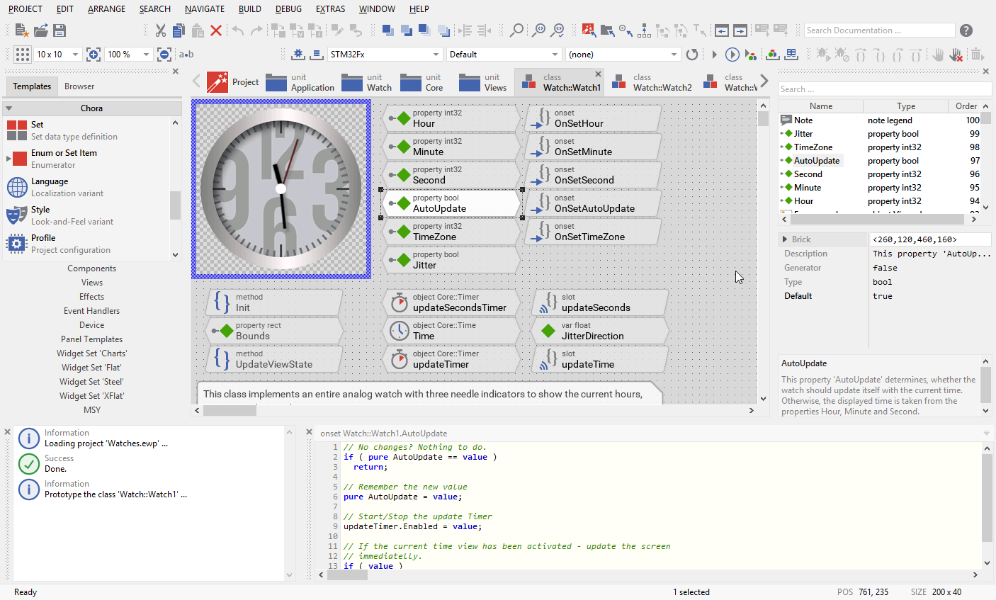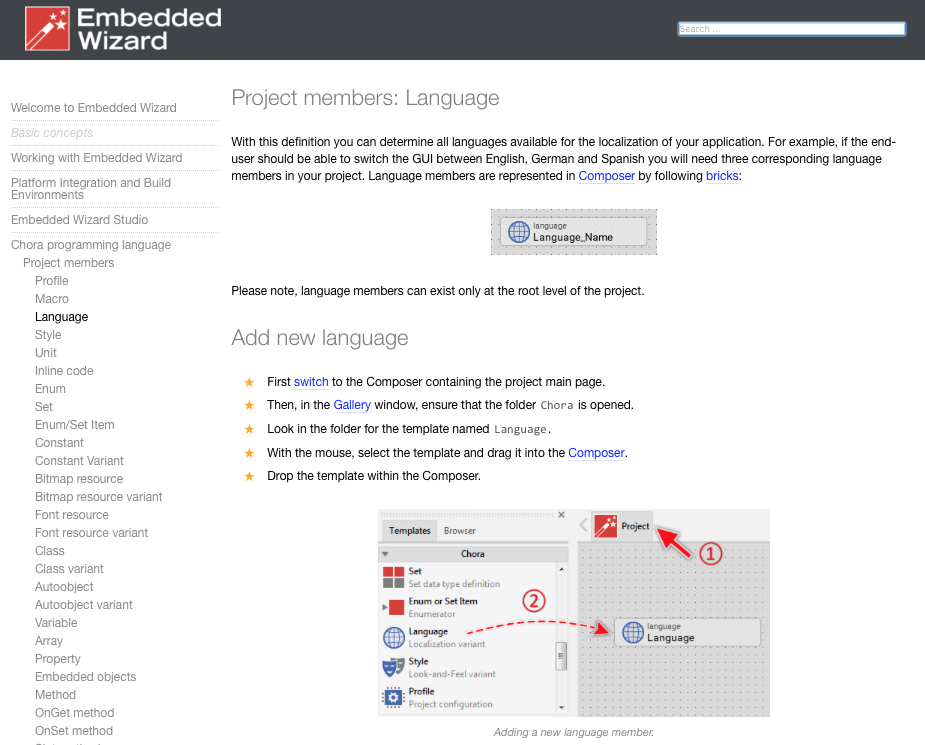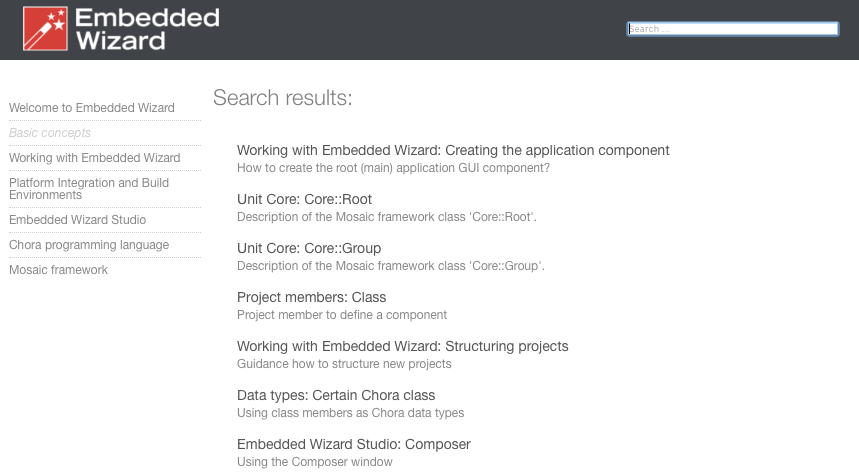Release notes: Embedded Wizard 8.00
This version is a preview release. This means, that all new features and improvements are completed and well tested – just the documentation is not completed. Please note, the included user manuals and the tutorial documentation are not yet updated.
Version V8.00 contains the following changes and improvements:
Redesign of Embedded Wizard Studio
We are happy to present a new look and feel for Embedded Wizard Studio!
With the new version V8.00 we introduce a completely new user interface with a modern and flat appearance.

All program icons and all brick symbols have been redesigned in order to have a modern face and to be more intuitive. The entire application and all dialogs have a flat and homogeneous appearance.
The Toolbars have been improved, useful menu shortcuts were added and the tooltips are enhanced. The handling of the dockable toolbars and windows has been simplified in order to avoid accidentally lost toolbars.
The Code Editor has an improved syntax highlighting with a better readability and shows line numbers.
The outdated feature ‘AspectRatio’ has been removed.
Support of HiDPI displays
Embedded Wizard Studio is now ready for HiDPI displays. The entire user interface of Embedded Wizard will adapt automatically according the current Windows display DPI settings.
Additionally, the list of zoom factors (used to zoom the Composer content) has been enhanced (from 25% to 800%). The user can select the appropriate zoom factor more convenient according the current DPI setting. 100% zoom means 1 pixel in the GUI corresponds to 1 pixel on the screen.
The workspace settings for different DPIs are saved now separately within the Registry to avoid conflicts when the DPI settings are changed.
Documentation system
The entire Embedded Wizard documentation is going to be reworked. As a result, the different separate documents (Embedded Wizard User Manual, Chora Reference Manual, Mosaic Reference Manual, Tutorial, HowTo-Documents,…) will be completely reworked and integrated into one all-embracing knowledge base.
The new documentation system is available on http://doc.embedded-wizard.de and will be enhanced continually.

The old documents ‘QuickTour’, ‘Embedded Wizard User Manual’ and ‘Tutorial’ are still available until the documentation system is not fully completed.
Please note: Since this version is a preview release, only parts of the help documents are available.
Context sensitive help
Embedded Wizard Studio supports now a context sensitive help. For this purpose a new documentation system is accessed.
Whenever a user presses the key ‘F1’, Embedded Wizard analyzes the current context (which item is selected and what is currently focused) and creates a search request for the documentation system.
As a result, a browser window is opened to present the user a list of related documents.

Please note: Since this version is a preview release, only parts of the help documents are available.
Open example project dialog
Embedded Wizard Studio contains a new menu item Open example... to have a quick access to the provided examples.
The entire task is covered within a single Open example project dialog.
In the dialog the user can select the desired sample project from a list of prepared / installed examples:

New sample: Watches
A couple of analog watches have been implemented – they can be seen within the new Watches sample.

New setup system
Embedded Wizard and all Platform Packages are now installed by using a new setup system. Each setup is provided as Microsoft software installation (*.msi). Additionally, all setups are digitally signed to confirm the software manufacturer and to guarantee that the software is not modified.
New color formats: RGB565 and RGB888
The set of supported basic color formats has been extended by the new formats called RGB565 and RGB888. In this case, the screen color format fits exactly to the physical color format of the display / framebuffer, although Embedded Wizard still operates internally with RGBA8888 color format in order to support alpha blending and highest UI quality.
This means, the RGB565 Platform Package works internally with two color formats: a RGB565 screen color format and a RGBA8888 native color format.
Similar, the RGB888 Platform Package supports two color formats: a RGB888 screen color format and a RGBA8888 native color format.
With this new color format Embedded Wizard supports now the following configurable color formats: RGBA8888, RGB888, RGBA4444, RGB565, RGB565A8, RGB555A8, LumA44, Index8, YUVA8888
Support for 64-bit systems
The new instant data type handle is added to the programming language Chora. The data type handle represents a target specific pointer, etc. important for 64 bit systems.
The Prototyper, the Debugger and the Code Generators have been adapted to support the new handle type. The Mosaic class library has been reworked in order to use handle for all references to target specific resources. Runtime Environment and Graphics Engine are reworked to work on 64-bit targets by using the 64-bit model LP64.
The OpenGL and OpenGL ES 2.0 based Platform Packages are reworked to operate correctly on 64-bit. The iOS application components are adapted to latest XCode and iOS version and support for 64-bit is added. The OSX application components are adapted to latest XCode and OSX version. Support for 64-bit is added as well.
Remark: This 64-bit enhancement does not include int64 data types.
Mosaic Improvements
★With Embedded Wizard V8.00 the old class library Mosaic 1.0 is no more supported. As a result, Mosaic20 is renamed to Mosaic, Templates20 is renamed to Templates and Examples20 is renamed to Examples.
★The class Core::Root contains now the method GetFPS() - helpful to measure the current frames per seconds of an UI animation.
★The set of timing functions within effect classes have been enhanced. A couple of new fancy timing functions are added to implement attractive effects - similarly to the easings of jQuery.
Bug Fixes
The following bugs have been solved:
★Graphics Engine: Bug fix in EwDrawText() function when the text ends with glyphs having negative x-offset. This caused the text to appear clipped at its right edge. Accordingly the function EwGetTextExtent() is adapted to calculate correctly the extent area with text that contains glyphs having negative x-offset at the end.
★Inspector: The members area of the Inspector is improved to not sort new members at the bottom end of the list. The members are sorted now accordingly to their Z-order.
